Sharks, Whales, and a Flexible Plan
By Anne Smrcina
August 2021
“That’s a really big fish! We may need a larger boat!” While these may sound like lines from a Hollywood movie, they are declarations during a real-life research cruise where scientists came across a massive white shark feeding on a whale carcass—an encounter that was not part of the original science plan.
Stellwagen Bank National Marine Sanctuary’s researchers are opportunists. They live by the proverbial phrase, “when life gives you lemons, make lemonade.” Recently, when a team from the Massachusetts Division of Marine Fisheries, the University of Massachusetts Amherst, and the sanctuary couldn’t find the basking sharks they were looking for, they turned to a fortuitous nearby event—The Center for Coastal Studies (CCS) had found several white and blue sharks scavenging on a dead humpback whale. The scene was a veritable ocean buffet, where the sharks gorged themselves on large bites of whale blubber, muscle, skin and organs, while seabirds milled around picking up scraps torn off by the fish.
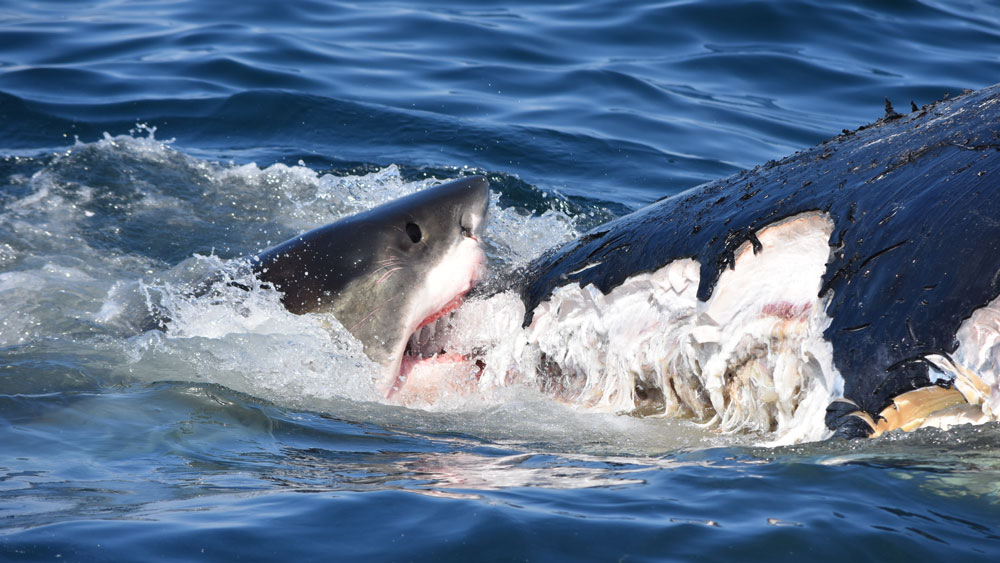
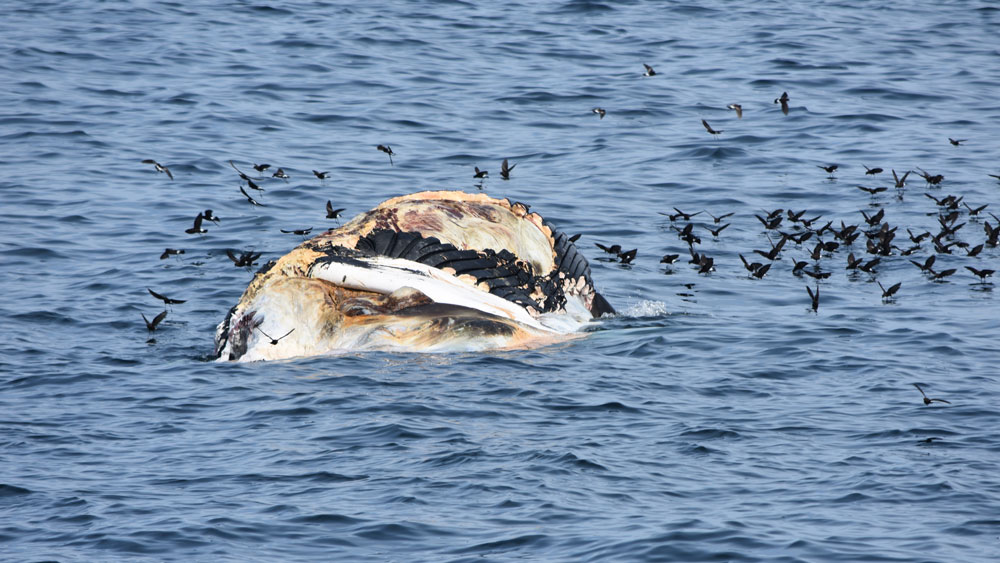
The dead humpback was the 2020 calf of a whale named Venom, a regular visitor to the sanctuary that was tagged by sanctuary scientists in the past. Humpback whale experts at CCS identified the juvenile whale after capturing underwater video footage of the underside of the whale’s tail. The patterns displayed on each tail are whale “fingerprints,” unique for each individual. In this case, the researchers were able to compare the video stills from the whale carcass to photos of Venom’s calf in the Gulf of Maine Humpback Whale Catalog. Although they were able to identify the whale, due to the severe predation, the CCS research team could not offer a verdict on the cause of death.
Lording over the scene was a white shark estimated at 17-18 feet in length. The research team, which included internationally recognized shark expert, Greg Skomal of the Massachusetts Division of Marine Fisheries and sanctuary research ecologist, David Wiley, were astounded by the shark. "The warm waters may have prevented basking sharks from showing up during this cruise, but we were able to shift our focus to white sharks, including one of the largest specimens I have ever encountered," said Skomal, who served as principal investigator for the mission. The team was working off the sanctuary’s 50-foot research vessel Auk and a 16-foot rigid hull inflatable boat (RHIB) named LuNa. "Partnering with the sanctuary allowed us to extend the reach of our shark studies using amazing on-the-water assets,” said Skomal.
The researchers decided to take the opportunity to tag the white sharks to try and learn more about them. Instead of the video tags they had intended to use on basking sharks, similar to the tags used during the sanctuary's humpback whale research, the team switched to acoustic transponders that are being used in Skomal’s long-term white shark study. While whale tags are attached with suction cups, and the basking shark tags would have used an implant attachment to tow the tag on a tether, the acoustic transponders are inserted 3-4 inches into the musculature at the base of the shark’s dorsal fin, like earrings through cartilage on humans.
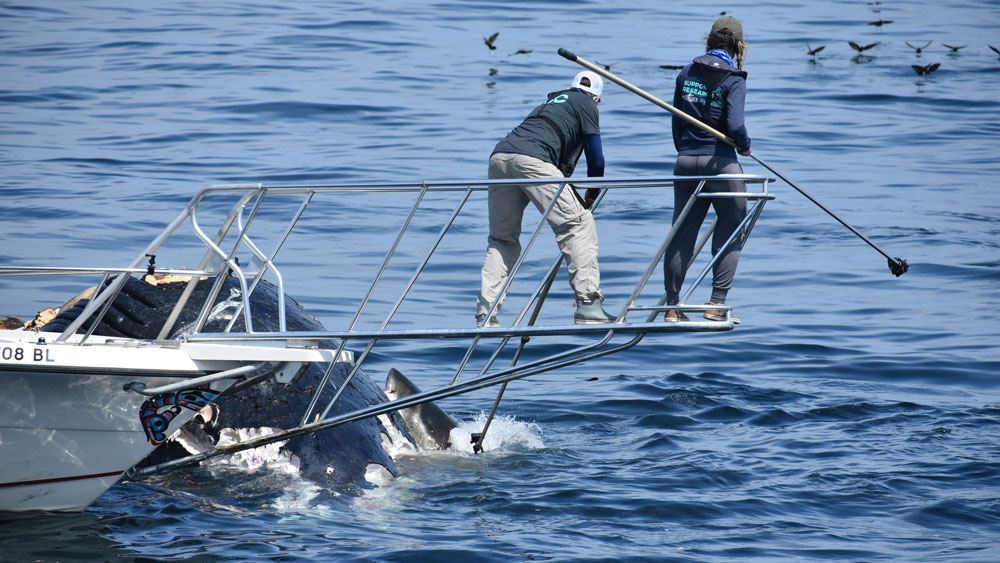
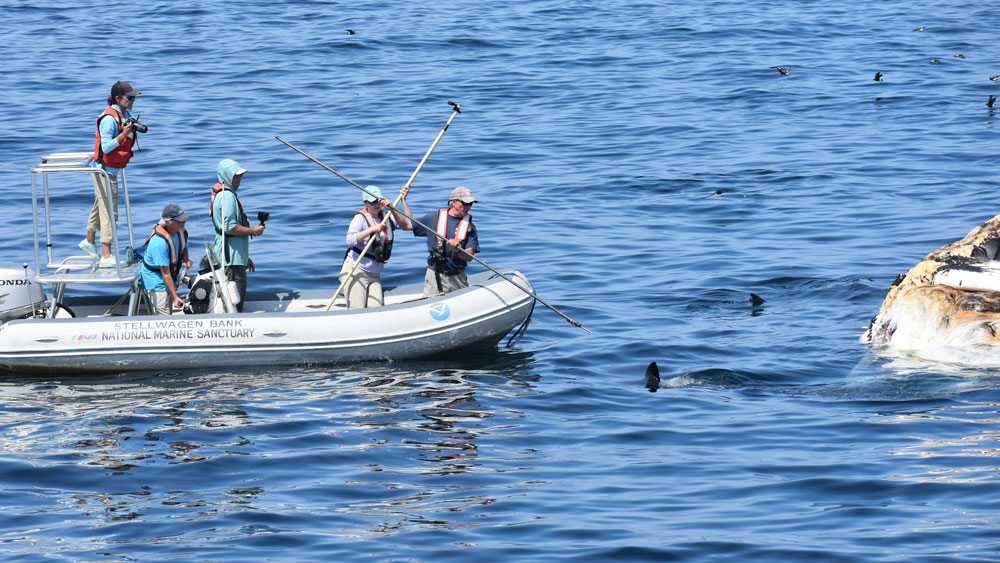
Once the whale tags detach, they are recovered and the data is downloaded, providing detailed information about the whale’s behaviors and movements underwater over a relatively short period of time, usually ranging from hours to a few days. The acoustic shark tags are simpler in design and function, but with a 10-year battery life that leads to a long-term data set.
These acoustic transmitters send out high frequency pings every 60-100 seconds. A network of more than 200 receivers throughout coastal Massachusetts waters, as well as other receivers in cooperative data sharing networks along the U.S. and Canadian East Coast, log the unique tag numbers, dates, and times when the sharks swim within listening range, usually several hundred meters. These data need to be downloaded periodically, although a few buoys are set up to provide real-time detections. The sanctuary contributes data from three sound “traps” in the sanctuary, part of a national SanctSound project.
“The opportunity to tag these massive sharks, some of them longer than the tag boat, was a unique experience,” said Grace Casselberry, a NOAA Nancy Foster Scholar and doctoral candidate at the University of Massachusetts Amherst. “These data provide important information about the fine- and broad-scale movements of white sharks in Massachusetts waters, the sanctuary, and all along the East Coast.”
The white shark research project, supported by the Commonwealth of Massachusetts and the Atlantic White Shark Conservancy, provides an archive of detections from this growing number of receivers that has more than a decade long history. The conservancy’s Sharktivity app and online logbook allow users to explore the archive of white shark detections.
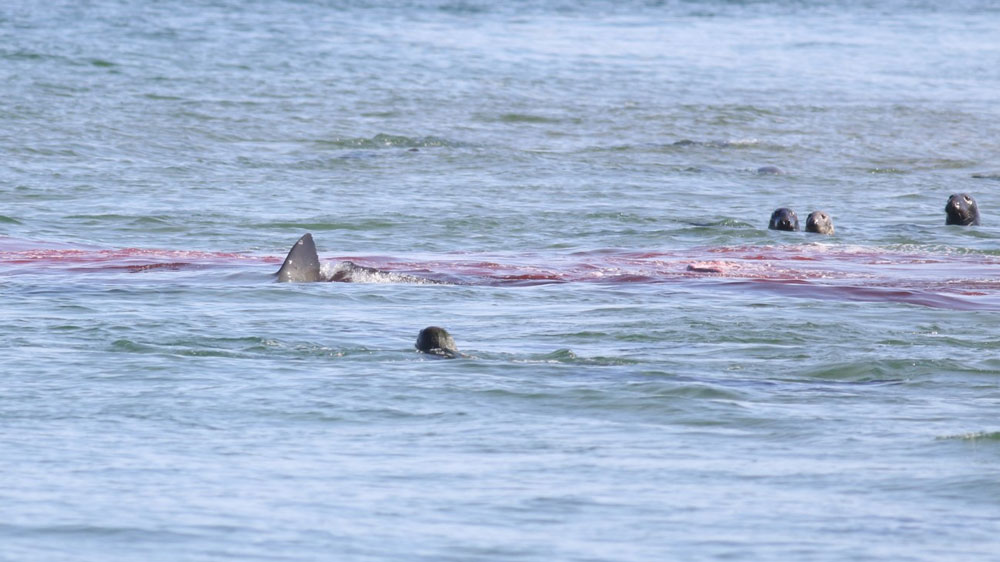
Interest in white sharks in Massachusetts has increased lately due to an uptick in the number of sightings at beaches. This is due to the increase in seal colonies along the coast, which provide prey for the sharks. The dead whale located in the southern portion of the sanctuary provided an easy meal for the sharks, who just as readily will scavenge as actively hunt. Although the death of the juvenile whale was a local tragedy mourned by the whale watch community, the carcass plays an important role in the food web, providing food both at the surface and later on the seafloor. When a whale dies at sea, its body often sinks to the seafloor. There, its carcass becomes what is known as a whale fall. The whale’s body provides a sudden, concentrated food source—a bonanza for organisms in the deep sea for years to come.
White shark populations are recovering from a significant decline that occurred in the 1970's and 1980's. They are a prohibited species, which means if caught, the shark must be released immediately, without removing it from the water and in a manner that maximizes its chances of survival.The sanctuary supports research, which employs strict safety protocols and follows all NOAA regulations, in an effort to better understand an important species in the regional ecosystem. This work was done under a sanctuary-issued permit.
Anne Smrcina is the education coordinator for Stellwagen Bank National Marine Sanctuary.

